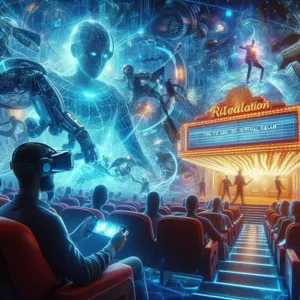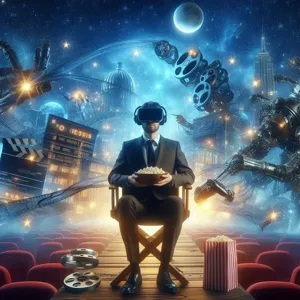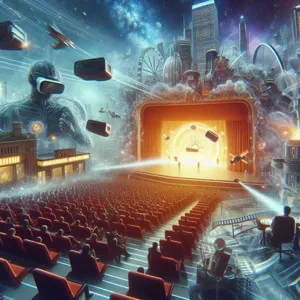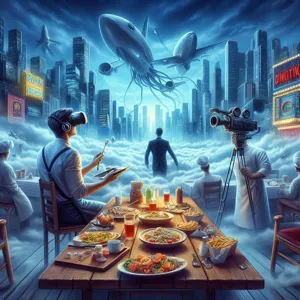As the world of entertainment continues to evolve at a breathtaking pace, one groundbreaking technology is poised to redefine the cinematic experience: virtual reality (VR).
Imagine stepping into a film, not merely as a spectator but as an active participant in a fully immersive world where you can explore, interact, and feel every moment as if you were truly there. With its ability to transport audiences beyond the confines of traditional storytelling, VR is challenging the very essence of how we consume visual narratives. In this blog post, we will delve into the transformative potential of virtual reality in cinema, exploring its innovative storytelling techniques, the technical challenges it presents, and how it could shape the future of filmmaking. Join us as we navigate this exciting frontier that promises to unlock new dimensions of creativity and engagement in the realm of cinema.
1. Introduction: The Evolution of Cinema

The world of cinema has undergone a remarkable transformation since its inception over a century ago. From the silent films of the early 1900s to the advent of sound, color, and special effects, each innovation has pushed the boundaries of storytelling and audience engagement. In the early days, films were simple visual narratives, often accompanied by live music to create an emotional atmosphere. As technology progressed, filmmakers began to experiment with sound, introducing dialogue that added depth to characters and storylines.
The introduction of Technicolor in the 1930s revolutionized the visual experience, captivating audiences with vibrant hues and lifelike imagery. The evolution continued into the late 20th century with the rise of CGI (computer-generated imagery), which allowed creators to bring fantastical worlds and impossible scenarios to life. Blockbuster hits like “Jurassic Park” and “Avatar” showcased the potential of digital effects, immersing viewers in awe-inspiring adventures that were once relegated to the realm of imagination.
As we reach the current decade, cinema finds itself at yet another pivotal juncture. The emergence of virtual reality (VR) technology presents a tantalizing frontier that could redefine how stories are told and experienced. Unlike traditional film, where the audience is a passive observer, VR invites viewers to step inside the narrative, allowing them to interact with characters and environments in a way that has never been possible before. This shift not only enhances immersion but also paves the way for novel storytelling techniques that blur the lines between filmmaker and audience.
In this post, we will explore the implications of VR in cinema, examining how this innovative medium could shape the future of storytelling and transform the way we experience film. The possibilities are vast, and as technology continues to advance, so too does our understanding of how stories can be told—opening the door to a new era of cinematic creativity.
2. What is Virtual Reality (VR)?
Virtual Reality (VR) is an immersive technology that transports users into a digitally created environment, providing a sensory experience that mimics the real world or conjures entirely new realms. At its core, VR combines computers, software, and hardware to make users feel as though they are physically present in a simulated space, effectively blurring the lines between reality and imagination.
Users typically engage with VR through headsets equipped with high-resolution screens and motion tracking sensors, which respond to head movements, allowing for a 360-degree view of the virtual environment. With the addition of gloves or handheld controllers, interactivity becomes a key component, enabling users to manipulate objects, navigate through spaces, and engage with digital characters in real-time.
In the context of cinema, VR transcends traditional storytelling by allowing audiences to step inside the narrative. Instead of passively watching a film unfold on a screen, viewers can explore the story from multiple perspectives, choosing where to look and how to interact with the environment around them. This level of engagement not only fosters a deeper emotional connection with the content but also opens new avenues for filmmakers to experiment with narrative structures and audience participation.
As technology continues to advance, VR is poised to redefine the cinematic experience, challenging filmmakers to craft stories that leverage this immersive medium. With its potential to create fully realized worlds, evoke powerful emotions, and engage viewers in unprecedented ways, Virtual Reality stands at the forefront of the next cinematic revolution, inviting audiences to not just watch a story unfold but to truly live it.
3. The Current State of VR Technology

The landscape of virtual reality (VR) technology has evolved dramatically over the past decade, transforming from a niche curiosity into a robust platform for entertainment and storytelling. Today, VR is at a pivotal point, characterized by significant advancements in hardware, software, and user experience. High-fidelity headsets, such as the Oculus Quest 2 and Valve Index, are now equipped with enhanced resolution, improved field of view, and advanced motion tracking, creating an immersive experience that captivates audiences and transports them into richly detailed virtual worlds.
Moreover, the development of standalone VR devices has made the technology more accessible than ever. Gone are the days when users needed cumbersome setups with external sensors and powerful gaming rigs. Current headsets often come with user-friendly interfaces and wireless capabilities, allowing for untethered exploration of virtual environments. This ease of use opens the door for filmmakers and storytellers to reach broader audiences, inviting them to step into a narrative rather than simply watch it unfold on a screen.
On the software front, creative tools and platforms are emerging that cater specifically to VR content creation. Programs like Unity and Unreal Engine empower filmmakers to craft interactive experiences that can engage viewers in unprecedented ways. With interactive narratives, audiences become active participants in the story, making choices that influence the outcome—an evolution in storytelling that traditional cinema cannot replicate.
However, despite these advancements, challenges remain. The industry still grapples with issues like high production costs, a limited library of compelling content, and the need for a more universal standard to ensure compatibility across various devices. Furthermore, while VR experiences can be profoundly engaging, they can also induce discomfort for some users, posing hurdles in terms of widespread adoption.
As we continue to explore the current state of VR technology, it becomes clear that while it is not yet a mainstream medium for cinema, its potential is undeniable. With ongoing innovation and a growing interest from filmmakers and audiences alike, VR stands poised to redefine how we experience storytelling, making it an exciting frontier in the world of cinema.
4. How VR Transforms Storytelling in Film
Virtual reality (VR) is revolutionizing the art of storytelling in film, offering an immersive experience that traditional cinema simply cannot replicate. Unlike conventional movies, where viewers passively absorb a linear narrative from a fixed perspective, VR invites them into an interactive realm where they become active participants in the story. This transformative approach allows filmmakers to craft narratives that are not only visually stunning but also deeply engaging on an emotional level.
Imagine stepping into a meticulously designed world where you can look around and explore your surroundings, interacting with characters and objects as the plot unfolds. In VR, the viewer’s gaze and movements influence the storytelling, creating a personalized journey that can vary from one audience member to another. This level of engagement fosters a unique sense of presence, making the viewer feel as though they are part of the narrative rather than merely observing it from afar.
Filmmakers are harnessing this technology to push the boundaries of creativity. They can create multi-dimensional characters whose arcs evolve based on audience interactions, or design nonlinear narratives that allow viewers to choose their own paths through the story. This new form of storytelling invites exploration and discovery, as viewers can revisit the experience multiple times and uncover different layers of the narrative with each encounter.
Moreover, VR has the potential to expand the emotional depth of a film. By placing the viewer directly in critical moments of the story—whether it’s standing side-by-side with a protagonist in a moment of triumph or facing the consequences of their decisions—VR can amplify feelings of empathy and connection. The immersive nature of virtual reality allows audiences to experience the highs and lows of a character’s journey in a way that traditional cinema often struggles to achieve.
As we stand on the cusp of this new era in filmmaking, it is clear that VR is not just a technological advancement; it is a powerful medium that can redefine how stories are told and experienced. As filmmakers continue to experiment and innovate, we can expect to see a wave of groundbreaking narratives that leverage the unique capabilities of virtual reality, transforming cinema into an even more dynamic and engaging art form.
5. Immersive Experiences: Engaging Audiences Like Never Before

As the cinematic landscape continues to evolve, virtual reality (VR) emerges as a groundbreaking medium, offering immersive experiences that engage audiences like never before. Unlike traditional film, where viewers passively watch a story unfold, VR invites them to step inside the narrative, granting them agency and a sense of presence that transcends the limitations of the screen. This transformative capability allows filmmakers to construct rich, interactive worlds where audiences can explore at their own pace, making choices that influence the storyline.
Imagine donning a VR headset and being transported to the bustling streets of a futuristic city, where the sights and sounds envelop you, making you feel as if you are part of the action. The ability to look around, interact with characters, and even manipulate elements of the environment creates a deeply personal connection to the story. This level of engagement not only enhances the emotional impact of the narrative but also fosters a more profound understanding of its themes and characters.
Moreover, VR experiences can be tailored to individual preferences, offering diverse pathways through the same story. This personalization allows viewers to experience narratives in ways that resonate with their own emotions and experiences, leading to a unique cinematic adventure for each participant. As filmmakers experiment with this technology, we are witnessing an exciting shift in storytelling—one that challenges the very notion of what it means to watch a film.
As the industry embraces this new frontier, it also opens the door to collaborative experiences, where audiences can share their journeys with friends and family in virtual spaces. Picture a group of friends navigating a suspenseful thriller together, each taking on different roles within the story. The shared laughter, gasps, and discussions that ensue amplify the enjoyment and create lasting memories, reinforcing the communal aspect of cinema.
Ultimately, immersive VR experiences promise to redefine our relationship with storytelling, creating a dynamic interplay between the audience and the narrative. As technology continues to advance and creators push the boundaries of imagination, we stand on the precipice of a cinematic revolution—one that invites us to not just watch a story, but to live it. The future of cinema is not just in the frames we see but in the worlds we can explore, and VR is leading the way into this exhilarating new dimension.
6. Case Studies: Successful VR Films and Experiences
As the boundaries of storytelling continue to expand, several pioneering projects have emerged, showcasing the potential of virtual reality (VR) in the cinematic landscape. These case studies not only highlight the innovative use of technology but also the unique ways that VR can immerse audiences, transcending traditional viewing experiences.
One standout example is **”The Invisible Man,”** a short film directed by Leigh Whannell, which utilizes VR to place viewers directly into the narrative. Participants don a VR headset, stepping into the shoes of the protagonist who is haunted by an unseen menace. This experience amplifies the feelings of suspense and isolation, allowing audiences to truly feel the terror of being pursued. The film’s clever integration of sound design and environmental effects immerses viewers in a way that traditional cinema simply cannot replicate.
Another notable case is **”Notes on Blindness,”** an interactive VR experience based on the real-life audio diaries of theologian John Hull, who lost his sight. This project allows users to navigate through Hull’s memories and sensory perceptions, offering a profound understanding of what it means to experience the world without sight. By engaging multiple senses and providing an intimate glimpse into Hull’s journey, “Notes on Blindness” not only educates but also evokes empathy in a deeply impactful way.
Then there’s **”Wolves in the Walls,”** a VR adaptation of Neil Gaiman’s beloved children’s book. This interactive narrative invites viewers to explore a richly designed environment while following the story of a young girl who believes wolves are lurking in her house. By allowing users to interact with the characters and the surroundings, the experience encourages a level of engagement that is both playful and thought-provoking, bridging the gap between literature and immersive storytelling.
These case studies exemplify the transformative power of VR in the realm of cinema, illustrating how this technology can enhance storytelling, evoke emotions, and create memorable experiences. As filmmakers continue to experiment with VR, it becomes increasingly clear that the medium offers a new frontier for creative expression, inviting audiences to step inside the stories they love. As we look to the future, these successful examples serve as a testament to the exciting possibilities that lie ahead in the intersection of virtual reality and cinema.
7. The Role of Interactivity in VR Cinema

As we delve deeper into the realm of virtual reality, one of the most compelling aspects that sets it apart from traditional cinema is the element of interactivity. In contrast to the passive viewing experience of watching a film on a screen, VR cinema invites audiences to step into the narrative, becoming active participants in the unfolding story. This shift from passive consumption to active engagement creates a unique bond between the viewer and the cinematic world, significantly enhancing the emotional resonance of the experience.
Imagine donning a VR headset and finding yourself in a bustling medieval marketplace, where you can choose to interact with characters, explore hidden corners, or even influence the events around you. The power of choice not only immerses viewers in the story but also allows for personalized experiences that vary from one individual to another. This interactivity can lead to multiple storylines, giving audiences the freedom to navigate their journey based on their preferences, making every viewing a unique adventure.
Moreover, the role of interactivity extends beyond mere choice; it also encompasses elements such as physical engagement. In some VR experiences, users can manipulate objects, solve puzzles, or perform actions that affect the storyline’s direction. This kinesthetic involvement can heighten the stakes of the narrative, fostering a deeper emotional connection with the characters and the world they inhabit.
As filmmakers experiment with this interactive format, we are likely to see innovative storytelling techniques emerge, blurring the lines between the creator and the audience. The ability to craft narratives that respond to the viewer’s actions opens a Pandora’s box of creative possibilities, from branching storylines to fully immersive environments that react to the user’s decisions.
In essence, interactivity stands at the forefront of VR cinema, promising to redefine how we experience storytelling. As technology continues to evolve and audiences become more accustomed to interactive formats, the potential for VR cinema to revolutionize the film industry becomes increasingly apparent. The future of storytelling is not just about watching a story unfold; it’s about living it.
8. Challenges Facing VR in the Film Industry
While the potential for virtual reality (VR) in the film industry is undeniably exciting, there are several challenges that filmmakers and studios must navigate as they venture into this uncharted territory. One of the most significant hurdles is the technology itself. VR requires specialized equipment, such as headsets and high-performance computers, which can pose accessibility issues for audiences. The cost of entry can deter casual viewers, limiting the reach of VR films and potentially confining them to niche markets.
Moreover, the storytelling techniques that work in traditional cinema do not always translate seamlessly to the VR format. Filmmakers must rethink narrative structures, pacing, and audience engagement, all while considering the immersive nature of the medium. Unlike conventional films, where the viewer is a passive observer, VR demands active participation, which can be both exhilarating and daunting. Crafting a compelling experience that keeps viewers engaged without overwhelming them is a delicate balancing act.
Additionally, the production processes for VR films are often more complex and time-consuming than their 2D counterparts. Filmmakers need to invest in new skills and training to master VR-specific techniques, such as spatial audio and 360-degree cinematography. This learning curve can slow down production timelines and increase costs, posing a challenge for independent filmmakers and smaller studios.
Distribution also presents a significant barrier. Currently, there are limited platforms for showcasing VR content, which can make it difficult for filmmakers to reach their audience. Unlike traditional films that can easily be screened in theaters or distributed on streaming platforms, VR experiences often require specific hardware and software, which can complicate the viewing process.
Lastly, there’s the question of audience comfort. While some viewers may embrace the immersive experience of VR, others may find it disorienting or even physically uncomfortable. Motion sickness and the overall sensory overload that can accompany VR experiences may deter a portion of the audience from fully engaging with the medium.
Despite these challenges, the potential for VR to revolutionize cinema remains. By addressing these obstacles head-on, the industry can pave the way for a new era of storytelling that captivates audiences in ways previously thought impossible. As technology evolves and creators adapt, the dream of a fully immersive cinematic experience may soon become a reality.
9. The Impact of VR on Traditional Filmmaking Techniques
As virtual reality (VR) continues to carve out its niche in the cinematic landscape, its influence on traditional filmmaking techniques is becoming increasingly pronounced. The immersive nature of VR offers filmmakers an innovative toolset that challenges conventional storytelling methods, pushing the boundaries of how narratives are crafted and experienced.
In traditional cinema, the filmmaker wields a significant amount of control over the viewer’s experience—framing shots, guiding attention with edits, and orchestrating emotional responses through carefully curated soundtracks. However, VR flips this paradigm on its head, placing the viewer at the center of the action. In a VR environment, audiences can look around, explore, and interact with the world in ways that traditional film does not allow. This shift necessitates a reevaluation of how stories are told; instead of a linear narrative, filmmakers must consider non-linear experiences that encourage exploration and personal engagement.
Moreover, the visual and auditory design of VR content pushes filmmakers to think beyond the standard cinematic techniques. With 360-degree views, sound design must be spatially aware, creating an enveloping auditory landscape that enhances the immersive experience. Techniques like dynamic audio positioning and environmental sound cues become crucial components, drawing viewers deeper into the narrative.
The integration of VR into the filmmaking process also opens up new avenues for collaboration between creators. Traditional roles such as director, cinematographer, and editor evolve as teams work together to create an interactive experience. The storytelling process becomes more fluid, with input from game designers, sound engineers, and animators merging seamlessly to construct a cohesive VR narrative.
As filmmakers experiment with VR, we’re witnessing the emergence of hybrid storytelling methods that blend cinematic techniques with interactive elements. From branching narratives that allow viewers to choose their own path to experiences that incorporate real-time decision-making, the potential for innovation is staggering.
Ultimately, the impact of VR on traditional filmmaking techniques is a reflection of a broader shift in how we consume media. As audiences increasingly demand more engaging and interactive experiences, filmmakers must adapt, embracing the challenges and opportunities that VR presents. This evolution not only enriches the cinematic experience but also sparks a conversation about the future of storytelling in a world where boundaries continue to blur.
10. The Future of VR: Trends and Predictions
As we stand on the cusp of a new era in entertainment, the future of virtual reality (VR) in cinema is filled with promising trends and intriguing predictions. Industry experts and creatives alike are starting to envision a world where traditional storytelling meets immersive experiences, creating a new dimension for filmmakers and audiences.
One significant trend is the increasing integration of VR with artificial intelligence (AI), paving the way for personalized storytelling. Imagine stepping into a narrative where the plot twists based on your choices and actions, guided by an intelligent system that learns your preferences over time. This level of interactivity could redefine audience engagement, making viewers active participants rather than passive observers.
Another exciting development is the rise of social VR experiences. As technology evolves, platforms are emerging that allow groups of people to experience films together, regardless of their physical locations. This communal aspect can enhance the emotional impact of a story, as viewers share reactions and immerse themselves in the narrative as a collective.
Furthermore, the accessibility of VR technology is expanding rapidly. With advancements in affordable headsets and mobile VR solutions, creators can reach wider audiences, democratizing the art of storytelling. As more filmmakers experiment with VR, we can expect a surge of diverse narratives that reflect varied cultural experiences, pushing the boundaries of conventional cinema.
Lastly, as the industry matures, we may see the establishment of VR film festivals and awards, legitimizing this medium and attracting talent from traditional film backgrounds. These events could serve as incubators for new ideas and collaborations, ultimately enriching the cinematic landscape.
In essence, the future of virtual reality in cinema is not just about enhancing visuals; it’s about transforming the way we connect with stories. As we look ahead, it’s clear that VR holds the potential to revolutionize the film industry, creating an immersive frontier that beckons both creators and audiences into uncharted territories of imagination.
11. Audience Reception: How Viewers Are Adapting to VR
As the cinematic landscape continues to evolve, audience reception to virtual reality (VR) is a fascinating aspect to explore. With VR headsets becoming increasingly accessible and immersive experiences on the rise, viewers are beginning to adapt to this new medium in remarkable ways. Unlike traditional cinema, where audiences passively absorb a story, VR invites them to step inside the narrative, transforming them from mere spectators into active participants.
Initially, many viewers approached VR with skepticism, unsure of how this technology could enhance their cinematic experience. However, as VR experiences have grown in sophistication, so too has the audience’s willingness to embrace this frontier. For instance, films designed specifically for VR often encourage exploration, allowing viewers to look around and interact with the environment. This level of engagement fosters a deeper emotional connection to the story, as audiences find themselves navigating the scenes and making choices that influence their experience.
Moreover, social dynamics are shifting as audiences begin to share VR experiences. Watching a film in a traditional theater is often a solitary affair, but VR can create opportunities for communal viewing, where friends or family can gather in a virtual space to experience a film together, even if they are physically apart. This evolution in how films are consumed has the potential to redefine not only storytelling but also how we connect with one another through cinematic art.
As viewers adapt to this immersive format, there are still challenges to overcome. Some may experience motion sickness or discomfort, which can detract from the enjoyment. However, as technology advances and creators become more attuned to audience preferences, the potential for VR to revolutionize cinema remains immense. With each new VR release, viewers are not just watching a story unfold; they are stepping into a new world, one that promises to captivate and inspire for years to come. The question is no longer whether VR will become a staple in cinema, but how quickly audiences will embrace this thrilling evolution.
12. Collaborations Between Filmmakers and VR Developers
As the boundaries between traditional cinema and virtual reality continue to blur, collaborations between filmmakers and VR developers are emerging as a powerful catalyst for innovation in storytelling. This synergy allows for the exploration of narratives in ways that were previously unimaginable, transforming passive viewing experiences into immersive journeys that engage audiences on a profoundly personal level.
Imagine stepping into a film where you don’t just watch the story unfold, but you become an integral part of it. Filmmakers, once confined to the linear progression of a screenplay, are now partnering with VR developers to craft multi-dimensional narratives that allow viewers to explore settings, interact with characters, and make choices that influence the story’s outcome. This shift not only enhances the emotional impact of the narrative but also invites viewers to participate actively, fostering a deeper connection to the story.
One striking example of this collaboration can be found in projects like “The Invisible Man,” which has seen VR experiences that extend the film’s universe, allowing audiences to step inside the protagonist’s world and confront fears in real-time. Such projects showcase how VR can amplify the themes of a film, providing a rich, immersive environment that extends beyond the traditional screen.
Moreover, these collaborations often lead to the development of cutting-edge technology that enhances the cinematic experience. Filmmakers and VR developers are experimenting with tools like spatial audio, 360-degree visuals, and haptic feedback to create a more captivating and authentic experience. As they share their expertise, they push the boundaries of what’s possible, paving the way for a new genre of storytelling that can redefine audience engagement.
In essence, the partnership between filmmakers and VR developers is not just about creating a new form of entertainment; it is about reimagining the very essence of storytelling. As these collaborations continue to evolve, they hold the potential to revolutionize cinema in ways that invite audiences to not only watch but to truly experience the stories being told. The future of film lies in this dynamic interplay, and the possibilities are as limitless as the imagination itself.
13. The Potential for VR in Film Festivals and Distribution
The rise of virtual reality (VR) technology is not just reshaping how audiences experience films, but it is also stirring up the very foundations of film festivals and distribution strategies. As traditional cinemas grapple with the challenges posed by streaming services and changing viewing habits, VR offers a fresh canvas for creators and distributors to explore innovative ways to engage with audiences.
Imagine stepping into a film festival where the boundaries of reality blur and the stories envelop you from every angle. VR technology allows filmmakers to craft immersive narratives, enabling viewers to step into the shoes of characters and experience stories in a uniquely personal way. Festivals like Sundance and Tribeca have already begun to embrace VR with dedicated sections showcasing virtual experiences that captivate and intrigue. These immersive installations not only provide a platform for emerging VR creators but also attract tech-savvy audiences eager to experience narrative in an entirely new dimension.
Moreover, the distribution landscape is evolving alongside this immersive technology. Traditional distribution methods, often limited by geographic and physical constraints, can be transformed through VR. Imagine a world where film premieres happen in virtual environments, allowing a global audience to attend simultaneously, breaking down barriers of distance and accessibility. Filmmakers can now reach audiences directly through VR platforms, creating tailored experiences that resonate with viewers on an emotional level.
With the potential for interactivity and audience engagement, VR can redefine how stories are told and shared. By incorporating elements such as audience choices or immersive environments, filmmakers can create a dialogue with their viewers, making them active participants rather than passive observers. As we stand on the brink of this technological evolution, the integration of VR into film festivals and distribution presents a thrilling opportunity for innovation and creativity in the cinematic landscape. The future of film could very well lie in the hands of VR, allowing us to experience stories in ways we’ve only just begun to imagine.
14. Conclusion: The Future of Cinema in a VR World
As we stand on the brink of a new era in storytelling, the intersection of virtual reality (VR) and cinema presents a tantalizing glimpse into the future of entertainment. The traditional cinema experience, with its linear narrative and fixed perspectives, is being challenged by the immersive possibilities that VR offers. Audiences are no longer passive viewers; they are active participants in the narrative, able to explore virtual worlds and engage with characters in ways that were previously unimaginable.
The potential for VR to revolutionize the cinematic landscape is immense. Filmmakers can craft intricate, multi-dimensional stories that invite viewers to navigate their environments, creating personalized experiences that resonate on a deeper level. Imagine stepping into a hauntingly beautiful landscape, feeling the rush of wind as you follow the story, or interacting with characters who respond to your presence. This interactive dimension not only enhances engagement but also fosters a profound emotional connection between the audience and the narrative.
However, the journey into this new frontier will not be without its challenges. Technical limitations, production costs, and the need for new storytelling techniques will require filmmakers to adapt and innovate continually. Moreover, the question of accessibility must be addressed; as VR technology evolves, creating experiences that are inclusive and widely available will be crucial for mainstream acceptance.
In conclusion, while the integration of virtual reality into cinema is still in its infancy, the possibilities are undeniably exciting. As filmmakers and technologists collaborate to push the boundaries of this medium, we can anticipate a future where cinema is not just watched but experienced. The allure of VR in storytelling may very well redefine the way we perceive and engage with narratives, marking a significant shift in the cultural landscape of entertainment. As we look ahead, one thing is clear: the future of cinema in a VR world is not just a possibility; it is an exhilarating reality waiting to unfold.
15. Call to Action: Exploring VR Experiences Today
As the cinematic landscape continues to evolve, the call to action for filmmakers, audiences, and tech enthusiasts alike is clear: dive into the immersive world of virtual reality experiences today. With advancements in VR technology, the barriers that once separated viewers from the stories unfolding on screen are rapidly dissolving. Whether you’re a seasoned cinephile or a casual moviegoer, the opportunities to engage with VR are both exciting and accessible.
Start by exploring VR applications that transport you into the heart of the narrative. Platforms like Oculus Rift and HTC Vive offer a plethora of experiences ranging from interactive films to fully immersive environments where you can influence the plot’s direction. Some films are even being designed exclusively for VR, inviting you to step inside the story as a participant rather than a passive observer.
Don’t stop at just watching—consider creating your own content. With user-friendly tools and software emerging, aspiring filmmakers have the chance to experiment with VR storytelling techniques. Attend workshops or online courses focused on VR production to understand the nuances of crafting narratives that thrive in a three-dimensional space.
Moreover, film festivals are beginning to embrace VR as a legitimate medium, showcasing cutting-edge experiences that push the boundaries of traditional cinema. Seek out local or virtual festivals where you can witness groundbreaking work and engage with creators who are pioneering this new frontier.
In addition, social VR platforms like AltspaceVR and VRChat allow you to connect with fellow enthusiasts, discuss your favorite VR films, and even participate in live screenings. These communities are invaluable for sharing insights, discovering new experiences, and staying updated on the latest trends in VR cinema.
As the world of virtual reality continues to expand, the call to action is to not only experience but also participate in this burgeoning field. The next time you settle in for a film, consider strapping on a VR headset and stepping into a realm where cinema knows no bounds. Embrace the opportunity to explore, create, and engage in ways you never thought possible—because the future of cinema is waiting just beyond the screen.
In conclusion, as we stand on the brink of a technological revolution, virtual reality is poised to redefine the cinematic experience in ways we’ve only begun to imagine. The potential for immersive storytelling, enhanced emotional engagement, and interactive narratives opens up new avenues for filmmakers and audiences alike. As the tools and platforms for VR continue to evolve, we can anticipate a future where viewers are not just passive observers but active participants in the stories they love. Whether you’re a cinephile excited about the possibilities or a curious newcomer to the world of VR, one thing is clear: the fusion of virtual reality and cinema is an exhilarating journey that is just beginning. Embrace this new frontier, and get ready to experience film like never before!






